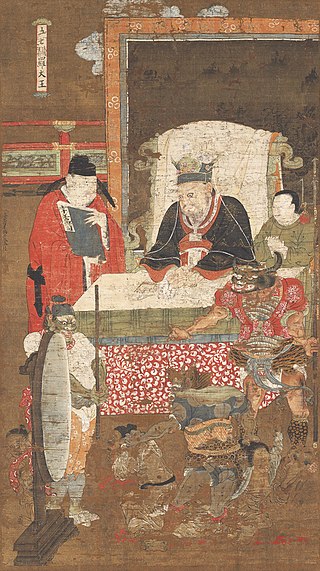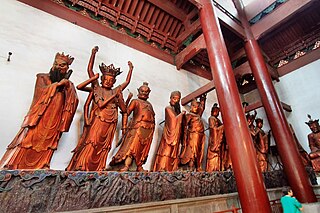The Four Heavenly Kings are the Buddhist protective deities.
Contents
Four Heavenly Kings may also refer to:
The Four Heavenly Kings are the Buddhist protective deities.
Four Heavenly Kings may also refer to:

Emperor Saga was the 52nd emperor of Japan, according to the traditional order of succession. Saga's reign spanned the years from 809 through 823.
The Golden Light Sutra or Suvarṇaprabhāsa Sūtra, also known by the Old Uygur title Altun Yaruq, is a Buddhist text of the Mahayana branch of Buddhism. In Sanskrit, the full title is The Sovereign King of Sutras, the Sublime Golden Light.

Tennōji is one of 24 wards of Osaka, Japan. It is named after the Shitennō-ji, the temple of the Four Heavenly Kings, which is located in the ward.

Vaiśravaṇa or Vessavaṇa, is one of the Four Heavenly Kings, and is considered an important figure in Buddhism. He is the god of warfare and usually portrayed as a warrior-king.

The Four Heavenly Kings are four Buddhist gods or devas, each of whom is believed to watch over one cardinal direction of the world. In the Sanskrit language of India, they are called the "Caturmahārāja" (चतुर्महाराज) or "Caturmahārājikādeva": "Four Great Kings". In Chinese mythology, they are known as "Sì Dàtiānwáng" or collectively as "Fēng Tiáo Yǔ Shùn". The Hall of Four Heavenly Kings is a standard component of Chinese Buddhist temples.
Kintarō is a folk hero from Japanese folklore. A child of superhuman strength, he was raised by a yama-uba on Mount Ashigara. He became friendly with the animals of the mountain, and later, after catching Shuten-dōji, the terror of the region around Mount Ōe, he became a loyal follower of Minamoto no Yorimitsu under the new name Sakata no Kintoki. He is a popular figure in Bunraku and kabuki drama, and it is a custom to put up a Kintarō doll on Boy's Day in the hope that boys will become equally brave and strong.

Minamoto no Yorimitsu, also known as Minamoto no Raikō, served the regents of the Fujiwara clan along with his brother Yorinobu, taking the violent measures the Fujiwara were themselves unable to take. He is one of the earliest Minamoto of historical note for his military exploits, and is known for quelling the bandits of Ōeyama.
The Amanojaku or Amanjaku is a prehistoric demon-like creature in Japanese folklore that has been recorded before Japan had a written language.

Sakakibara Yasumasa was a Japanese daimyō of the late Sengoku period through early Edo period, who served the Tokugawa clan. As one of the Tokugawa family's foremost military commanders, he was considered one of its "Four Guardian Kings" along with Sakai Tadatsugu, Honda Tadakatsu and Ii Naomasa. His court title was Shikibu-Shō (式部大輔).

Heavenly King or Tian Wang is a Chinese title for various religious deities and divine leaders throughout history, as well as an alternate form of the term Son of Heaven, referring to the emperor. The Chinese term for Heavenly King consists of two Chinese characters meaning "heaven/sky" and "king". The term was most notably used in its most recent sense as the title of the kings of the Taiping Heavenly Kingdom, but is also used in religious contexts as well.

In East Asian and Buddhist mythology, Yama or King Yan-lo/Yan-lo Wang, also known as King Yan/Yan Wang, Grandfatherly King Yan, Lord Yan, and Yan-lo, Son of Heaven, is the King of Hell and a dharmapala said to judge the dead and preside over the Narakas and the cycle of afterlife saṃsāra.

Shitennō-ji is a Buddhist temple in Ōsaka, Japan. It is also known as Arahaka-ji, Nanba-ji, or Mitsu-ji. The temple is sometimes regarded as the first Buddhist and oldest officially-administered temple in Japan, although the temple complex and buildings have been rebuilt over the centuries, with the last reconstruction taking place in 1963. Shortly after World War II, Shitennō-ji became independent of the parent Tendai sect, and formed the "Wa" sect of Buddhism.
Shitennō, a Japanese term normally referring to the Buddhist Four Heavenly Kings, is also applied to particularly famous or loyal retainers, in groups of four, to certain of Japan's most famous legendary and historical figures.
The Four Heavenly Kings of the Tokugawa is a Japanese sobriquet describing four highly effective samurai generals who fought on behalf of Tokugawa Ieyasu in Sengoku period. They were famous during their lifetimes as the four most fiercely loyal vassals of the Tokugawa clan in the early Edo period.

Shitennōji University is a private university in Habikino, Osaka, Japan. The predecessor of the school was founded in 1922, and it was chartered as a junior women's college in 1957. The school became a four-year college in 1967, and it became coeducational in 1981, adopting the present name at the same time. The school is also known as International Buddhist University, or IBU.
Sunny Wong Kwok-wing is a Hong Kong choreographer from the 1980s to the present. He has been in the dancing industry for over 30 years. He then started Sunny Wong Dance School in 2007 in order to train new age dancers. As the principal of the school, he put much effort on organizing courses for the teenagers and kids.
Four Guardians of the Kōdōkan refers to the four notable judo competitors of the early Kōdōkan: Tomita Tsunejirō, Yamashita Yoshitsugu, Yokoyama Sakujiro, and Saigō Shirō.

Virūpākṣa is a major deity in Buddhism. He is one of the Four Heavenly Kings and a dharmapala.

Dream 9 Toriko & One Piece & Dragon Ball Z Super Collaboration Special is an animated crossover television special which aired on April 7, 2013, on Fuji TV. It was made to commemorate the start of the third year of the Toriko anime, which premiered in April 2011, and it features characters from Dragon Ball Z, One Piece and Toriko. The special consists of two episodes which aired together: Episode 99 of Toriko, "Run, Strongest Team! Toriko, Luffy, and Goku!" (走れ最強軍団!トリコとルフィと悟空!), and episode 590 of One Piece, "History’s Strongest Collaboration Vs. Glutton of the Sea" (史上最強コラボVS海の大食漢).

The Twenty-Four Protective Deities or the Twenty-Four Devas, sometimes reduced to the Twenty Protective Deities or the Twenty Devas, are a group of dharmapalas in Chinese Buddhism who are venerated as defenders of the Buddhist dharma. The group consists of devas, naga kings, vajra-holders and other beings, mostly borrowed from Hinduism with some borrowed from Taoism.